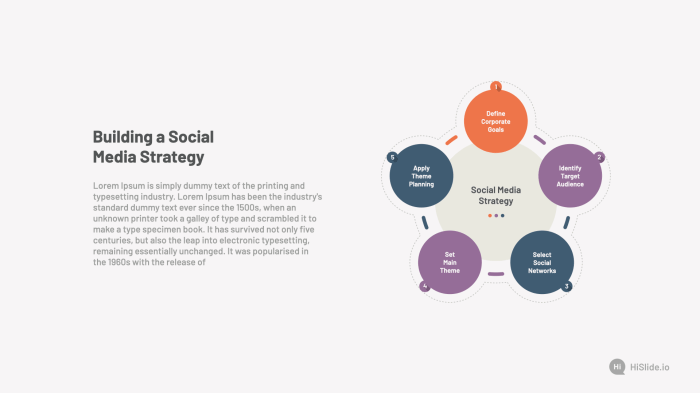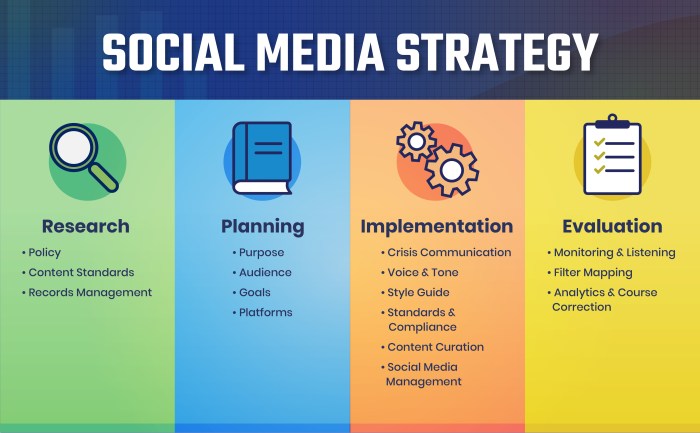Building a Social Media Strategy sets the stage for creating an online presence that resonates with your audience, combining creativity and data-driven decisions to achieve success. Get ready to dive into the world of social media strategy!
Overview of Social Media Strategy: Building A Social Media Strategy
A social media strategy is a detailed plan outlining how a business or individual will use social media platforms to achieve specific goals and objectives. It involves identifying the target audience, choosing the right platforms, creating engaging content, and measuring the effectiveness of the strategy.
Having a social media strategy is crucial in today’s digital age as it helps businesses and individuals build brand awareness, increase website traffic, generate leads, and engage with their audience. It also allows for better tracking of results and helps in adjusting the strategy for maximum impact.
Examples of Successful Social Media Strategies
- Nike: Nike’s social media strategy focuses on storytelling and user-generated content. They engage with their audience by sharing inspiring stories, showcasing top athletes, and encouraging users to share their own experiences with the brand.
- Starbucks: Starbucks uses social media to create a sense of community among its customers. They run interactive campaigns, share behind-the-scenes content, and respond to customer feedback in real-time, making their audience feel valued and connected.
- GoPro: GoPro’s social media strategy revolves around user-generated content. They encourage their customers to share photos and videos captured with their cameras, creating a community of loyal brand advocates who help promote their products organically.
Setting Goals for Social Media Strategy

Setting clear goals for a social media strategy is crucial for the success of any business. Goals provide direction, focus, and a way to measure the effectiveness of your efforts. Without clear goals, it’s easy to get off track and waste time and resources on activities that don’t contribute to your overall objectives.
Importance of Setting Clear Goals
Setting clear goals for your social media strategy helps you stay focused on what you want to achieve. It allows you to align your social media efforts with your business objectives and helps you prioritize tasks and allocate resources effectively. Additionally, having measurable goals enables you to track your progress and make adjustments as needed to ensure you are on the right path towards success.
Examples of Specific Goals
- Increase brand awareness by reaching 100,000 followers on Instagram within six months.
- Generate 500 leads per month through social media channels by offering exclusive promotions and discounts.
- Improve customer engagement by increasing the average number of comments and shares on Facebook posts by 20% in three months.
- Drive website traffic by achieving a 30% increase in referral traffic from social media platforms in one year.
Measurable and Achievable Goals
Setting goals that are measurable allows you to track progress and determine the success of your social media strategy. Make sure your goals are specific, quantifiable, and have a clear timeline for achievement. Additionally, ensure that your goals are achievable based on your resources, capabilities, and market conditions. It’s important to set realistic goals that push you to improve but are also within reach.
Identifying Target Audience
Identifying your target audience is a crucial step in creating an effective social media strategy. By understanding who your audience is, you can tailor your content to meet their specific needs and interests.
Process of Identifying Target Audience
When identifying your target audience for your social media strategy, consider factors such as demographics (age, gender, location), psychographics (interests, values, behaviors), and technographics (preferred social media platforms, online behavior). Conducting thorough audience research is essential to gather this information.
- Utilize social media analytics tools to track the demographics and interests of your current followers.
- Survey your existing customers to gather insights into their preferences and behaviors.
- Monitor conversations and engagement on social media platforms to identify trends and topics that resonate with your target audience.
- Collaborate with influencers or industry experts who have a similar target audience to gain valuable insights.
Importance of Tailoring Content to Target Audience
Tailoring your content to your target audience is essential for engaging and retaining followers on social media. By creating content that resonates with their demographics and interests, you can increase engagement, drive traffic to your website, and ultimately convert followers into customers.
Remember, the key to a successful social media strategy is knowing your audience and delivering content that speaks to their specific needs and interests.
Content Creation and Curation

Creating and curating content is a crucial aspect of any social media strategy. It helps in engaging the audience, building brand awareness, and driving traffic to your website or other platforms.
Tips for Creating Engaging Content
- Understand the platform: Tailor your content to fit the style and audience of each social media platform. What works on Instagram may not work on Twitter.
- Visual appeal: Use high-quality images, videos, and graphics to grab the attention of your audience. Visual content tends to perform better.
- Be authentic: Show the human side of your brand by sharing behind-the-scenes content, user-generated content, and stories that resonate with your audience.
- Use storytelling: Narratives are powerful in capturing attention and creating an emotional connection with your audience. Share stories that highlight your brand values and mission.
Importance of Curating Content, Building a Social Media Strategy
Curating content from various sources is essential to keep your audience interested and engaged. It helps in providing diverse perspectives, staying relevant, and offering valuable information that your audience may find interesting. By curating content, you can also establish your brand as a thought leader in your industry and build credibility among your followers.
Platform Selection and Optimization
When it comes to choosing the right social media platform for your content, it’s essential to consider the type of content you’ll be sharing and the audience you want to reach. Different platforms cater to different demographics and interests, so it’s crucial to select the platforms that align best with your goals.
Comparing Social Media Platforms
- Instagram: Ideal for visual content such as photos and videos, popular among younger audiences.
- Facebook: Great for sharing a variety of content types, has a wide user base across different age groups.
- Twitter: Best for short, concise updates and trending topics, used by a diverse range of users.
- LinkedIn: Perfect for professional networking and sharing industry-related content, targeting a more professional audience.
Optimizing Profiles
- Use high-quality profile pictures and cover photos that reflect your brand.
- Write a compelling bio that clearly describes who you are and what you do.
- Include relevant s in your profile to improve searchability.
- Regularly update your profile with new content to keep it fresh and engaging.
Consistency in Branding
Maintaining consistency in branding across all social media channels is crucial for building brand recognition and trust. Make sure to use the same logo, colors, and tone of voice across platforms to create a cohesive brand identity. This helps your audience easily recognize and connect with your brand, no matter which platform they are on.
Engagement and Community Building
Engaging with the audience on social media is crucial for building a strong relationship with your followers and customers. It helps create a sense of community around your brand, increases brand loyalty, and fosters trust.
Strategies for Building a Community
- Encourage interaction: Post engaging content that prompts your audience to like, comment, and share. Respond to comments and messages promptly to show that you value their input.
- Create exclusive content: Offer special promotions, behind-the-scenes glimpses, or sneak peeks to make your followers feel like part of an exclusive club.
- Host contests and giveaways: Organize fun competitions or giveaways to encourage participation and excitement among your audience.
- Celebrate milestones: Acknowledge and celebrate important milestones with your community, such as reaching a certain number of followers or years in business.
Role of User-Generated Content
User-generated content plays a significant role in fostering engagement and community building. When your followers create and share content related to your brand, it not only showcases their loyalty but also attracts new audiences who trust peer recommendations over traditional advertising.
Tracking and Analytics
Tracking metrics is crucial to evaluate the success of a social media strategy. By analyzing data and performance indicators, businesses can make informed decisions to optimize their strategies for better results.
Key Performance Indicators (KPIs)
- Engagement Rate: Measure the level of interaction (likes, comments, shares) your content receives.
- Conversion Rate: Track the percentage of users who take a desired action, such as making a purchase or signing up for a newsletter.
- Reach and Impressions: Monitor how many people see your posts and how often they are displayed.
- Click-Through Rate (CTR): Evaluate the number of clicks your content receives compared to the number of impressions.
Analyzing Social Media Analytics
When analyzing social media analytics, it’s essential to look beyond the numbers and understand the context behind the data. Here are steps to make informed decisions for strategy optimization:
- Identify trends and patterns in the data to see what is working and what needs improvement.
- Compare performance across different platforms to allocate resources effectively.
- Engage with audience feedback to adjust content and engagement strategies accordingly.
- Set benchmarks and goals to measure progress and adjust strategies as needed.
